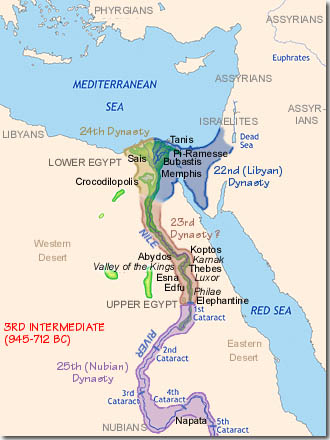| |
||||||
|
||||||
 |
|
|||||
| The country was split into two parts: the Theban Priesthood controlled Upper Egypt and Smedes (1070-1044 BC) - a royal relative and first pharaoh of the 21st Dynasty - controlled Lower Egypt. The 21st Dynasty moved the capital from Pi-Ramesse to Tanis,
also in the Delta, probably because the canal supplying Pi-Ramesse dried
out. At Tanis they launched an elaborate building campaign, one to rival
the Karnak temple of Amun in Thebes. They moved temples and palaces
from Pi-Ramesse to Tanis. They also moved the royal necropolis from
the Valley of the Kings to Tanis, where the intact tomb of Psusennes
I (1040-992 BC) was discovered in the late 1930’s. |
||||||
Meanwhile a new political force appeared in Egypt. Libyan mercenaries, drafted into the army since the late New Kingdom, now formed a large part of the Egyptian military. When Psusennes II (959-945 BC) died, his son-in-law, a Libyan general, became Shoshenq I (945-924 BC) of the 22nd Dynasty. The 22nd is called the Libyan or 'Bubastide' Dynasty since Shoshenq lived in the Delta-city of Bubastis. The early 22nd Libyan Dynasty kings were powerful rulers who (possibly) re-established an Egyptian presence in Asia. Shoshenq also appointed his own son as High Priest of Amun at Thebes - a post previously hereditary. There was the appearance of Egyptian unity. But the scant and patchy nature of the written records from this period suggest that unity was unsettled and temporary. Dynastic rivalry brought dissension. Usurpers apparently proclaimed a new Dynasty - the 23rd - either in the Delta or more likely at Thebes. The kings of the 23rd Dynasty ruled concurrently with those of the 22nd. This example was followed by Tefnakht I (725-720 BC), a prince in the Delta-city of Sais, who founded the 24th Dynasty. Not only was Egypt divided between the Delta and Thebes, but the Delta itself was divided as well. Taking advantage from these internal conflicts, a new power arose in Nubia to the south. There a Nubian dynasty formed intent on conquering Egypt. It was Piye (747-716 BC) who decided to push north and attack the other dynasties ruling the Nile Valley. In an effort to confront this Nubian invasion, the other three dynasties allied themselves, but were defeated. Piye managed to march as far as Memphis. |
 |
|||||
But the peace and stability resulting from the Nubian conquest was brought to an end by another external factor: the Assyrian 'war machine'. Although the presence of the Assyrians in Egypt was short-lived, the results were devastating. The Assyrians repeatedly attacked Memphis and the Delta. They savagely plundered and ransacked once-glorious Thebes. They destroyed many wonderful temples, including the mortuary temple of Ramesses II at Karnak. Up and down the Nile countless treasures and precious works of art were lost forever. Fortunately for Egypt, the Assyrians were forced to return to Assur. They left the king of Sais, Psammetichus I Psamtek (664-610 BC), the opportunity to try to take control of all Egypt. He reunited Middle and Lower Egypt and founded the 26th Dynasty. He extended his control over the whole of Egypt by 656 BC. He eventually felt strong enough to sever all ties with Assyria, and Assyrian influence disappeared. The 26th Dynasty, also called the 'Saite period', was a century of revived splendor for Egypt. During the reign of Apries (589-570 BC), an army was sent to help the Libyans eliminate the Greek colony at Cyrene. The disastrous defeat of this army brought on a civil war which resulted in Apries being replaced by Amasis (570-526 BC). According to contemporary Greek records, the long rule of Amasis was a peaceful and prosperous time in the Nile Valley. But he died in 526 BC, and the next year Egypt fell to new invaders, the Persians. The Perisan shah Cambyses (525-522 BC) is considered the first king of the 27th Dynasty. The latter part of the Later Dynasties Period starts and ends with a Persian occupation. The 27th Persian Dynasty lasted for more than a century. Disruptions back in Persia allowed the native Egyptian Amyrtaios (404-399 BC), the only king of the 28th Dynasty, to drive the Persians out of Egypt and re-establish control of the Nile Valley. Egypt’s regained independence lasted over 50 years. The kings of the 29th and 30th Dynasties ruled the country and restored the ancient Egyptian traditions. But Nectanebo II (360-343 BC) was the last native pharaoh to rule Egypt. The Persians briefly reconquered Egypt as the 31st Dynasty. This second Persian occupation only lasted for 10 years, but it was one of the darkest pages in the history of Ancient Egypt: temples were plundered, holy animals were butchered and the people were subjected to demanding tributes. Egypt’s ordeal during this occupation made it ready to welcome the Macedonian king Alexander the Great as its liberator. With the "conquest" of Egypt by Alexander, Egypt would become a Hellenistic state and a new era had begun.
|
||||||